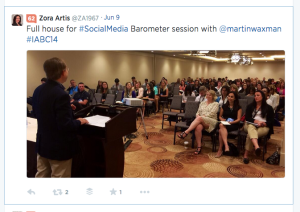Earlier in the month, I had the opportunity to present my Social Media Barometer to a roomful of communicators at the IABC World Conference, an event with a truly international flavour and smart people from around the globe. And I’d like to thank Zora Artis, who managed the marketing stream, for being such a good host (and for the photo in this post).
I’ve presented versions of this talk a number of times before and each one is a little different than the other because, as we all know, we’re in the midst of a vast transformation to the way we discover and share news, information and interests. And to the way we connect.
And who knows where we are in the change continuum – beginning, middle or end?
When I started in PR, I was an entertainment publicist and really proud of what I did. I knew – and so did my clients – that I had build relationships with a lot of reporters and I could call them and more often than not, they’d run with my story. (Because I had a good idea of what would interest them.) And that coverage would sell tickets or books, or get people to an event.
Then I became a PR agency professional and had to learn a whole new vocabulary – corporate-speak – and refer to publicity as media relations.
These days, I’m just @martinwaxman and, like many of us, I live a lot more of my life in public and my personal and professional worlds collide all the time in ways I would have never imagined.
To paraphrase author, professor and digital strategist Clay Shirky, where there was once scarcity (as in few media), we now have abundance (social media), amateurs competing directly with professionals every day.
Things have changed. I hope you’re not leaving voice mails for people when you’re asking them to do something. Actually, you probably never should have done that.
Emerging trends
I’ve noticed several that are reshaping the PR landscape and the way we communicate:
1. Search me – 93 per cent of our online experiences begin with search. And three-quarters of us don’t go past the first page when we’re looking for something. Couple that with customized, semantic search and discovery on social and mobile platforms and the notion of media clips just doesn’t cut it anymore. The question we should be asking when someone does a search is how can we be sure we come up as one of the top finds – and that we’re relevant.
2. New generation gap – You just have to look around the workplace and notice that millennials do things differently than their boomer/Gen X counterparts. A lot of research shows 35 is the dividing line and the new generation is media agonistic and looks at the world from a digital perspective. It’s time for boomers to listen to millennials and shift to a digital and mobile first approach.
3. Mobility means never having to say you can’t reach me – And speaking of mobile… More than half of us consider mobile the most important channel in the path to purchase. The key for all of us is to start thinking big ideas for the small screen.
4. Face of new media – The new big three media companies are Facebook, Google/YouTube and Twitter with LinkedIn in the role of WSJ and Pinterest as Life, the specialty network. And we’ve become the programmers, viewers producers and critics all rolled up into one. Trouble is, we don’t get paid.
5. We’re all in showbiz – Media’s adapting. PR can no longer sit idly by. We need to combine publishing and publicity and tell stories visually and not just with words. And add some sizzle to our work to entertain, educate and engage.
Here are the slides:
And where does communications fit into this? I think we should focus on three things: strategy, training and content.
What other changes do you see on the horizon? I’d be interested to hear.
A version of this post appeared in the IABC Victoria, Australia newsletter.

